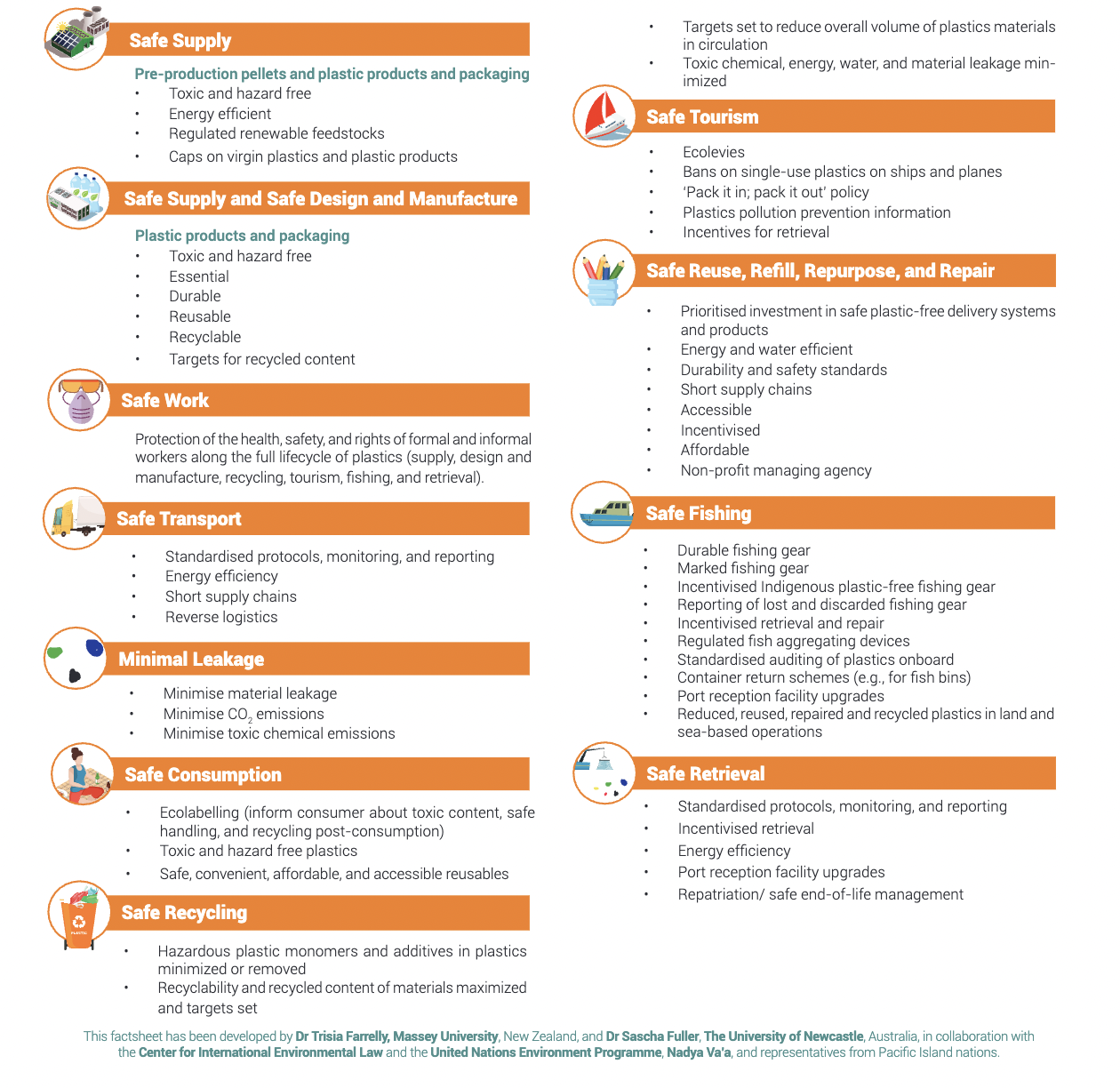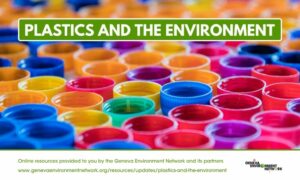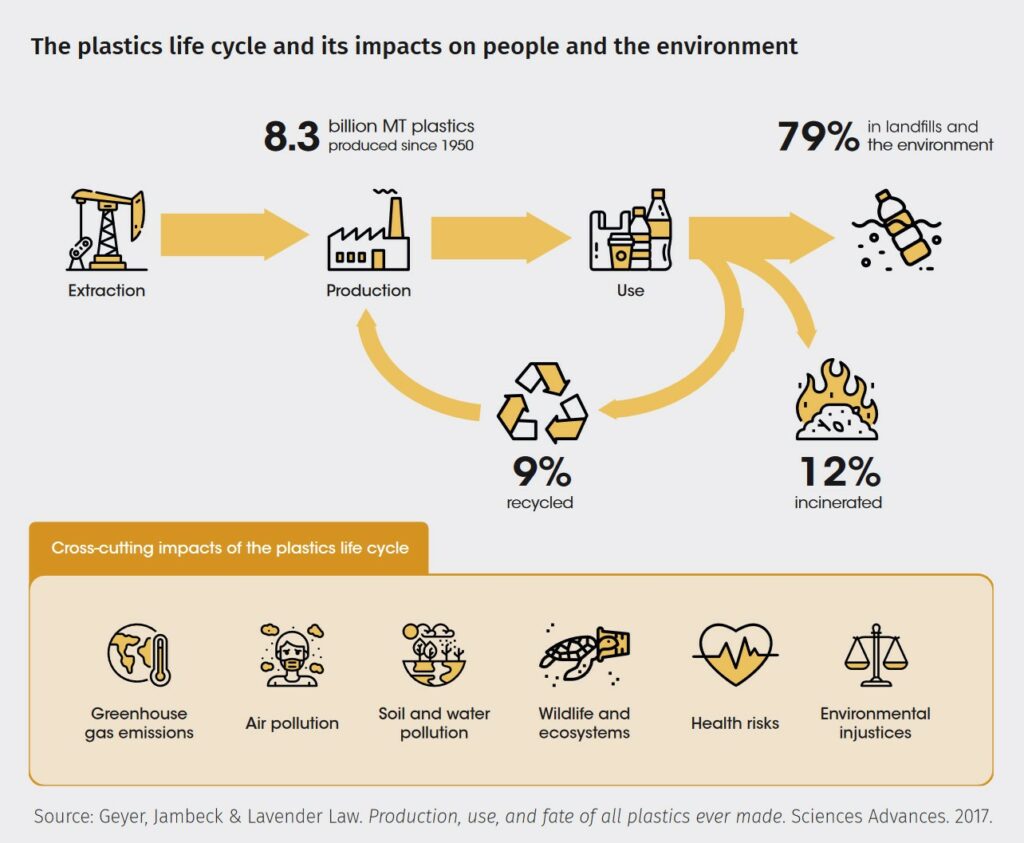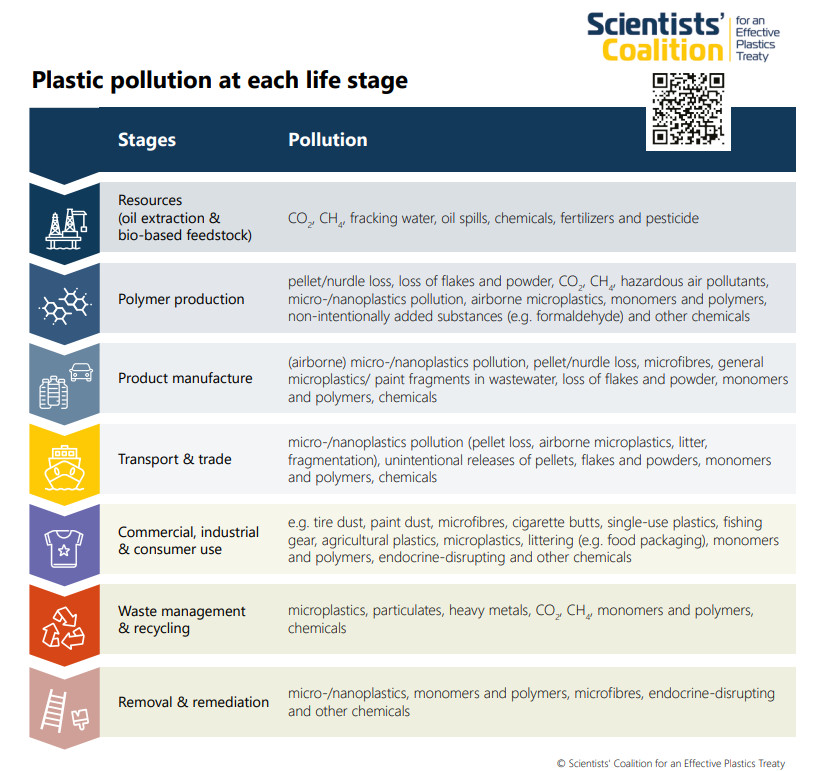Update
Plastics and the Environment
The world is facing a plastic crisis, the status quo is not an option. Plastic pollution is a serious issue of global concern which requires an urgent and international response involving all relevant actors at different levels. This page aims at listing relevant information, research, data and/or press releases issued by our partners in Geneva and other institutions around the world.
About
The Plastics and the Environment series is a set of online resources on the plastics crisis, its impact on people and the environment, and international cooperation to address this global problem. Compiled by the Geneva Environment Network, the series includes resources and news from organizations in Geneva and beyond, including UN-system organizations and other IOs, governmental authorities, civil society organizations, academic institutions and journals, and renowned newspapers. The page offers an overview of the different issues surrounding plastic pollution. Detailed information and resources are available for each section by clicking on the “In Focus” buttons.
LATEST NEWS
- Climate Impact of Primary Plastic Production | Karali Nihan; Khanna Nina and Shah Nihar | Lawrence Berkeley National Laboratory | 17 April 2024
- Civil Society Open Letter – No ambition with UAE in the HAC | 16 April 2024
- HAC Member States Ministerial Joint Statement for INC-4 | HAC | 15 April 2024
- Penultimate UN talks on global plastic pollution treaty will make or break the treaty: WWF | WWF | 15 April 2024
- Protecting the Developing Brains of Children from the Harmful Effects of Plastics and Toxic Chemicals in Plastics. Recommendations for Essential Policy Reforms in the New Global Treaty on Plastics | Project TENDR | 13 April 2024
- Aligning States Duties and Business Responsibilities Related to Plastics with the Guiding Principles on Business and Human Rights | Information Note to INC-4 | OHCHR | 11 April 2024
- Migration of endocrine and metabolism disrupting chemicals from plastic food packaging | Sarah Stevens, Zdenka Bartosova, Johannes Voelker, Martin Wagner | BioRixv | 10 April 2024
- Tiny plastic particles are found everywhere | University of Basel | 9 April 2024
- Plastics talks talk Trump | Politico | 9 April 2024
- Plastics in the deep sea – A global estimate of the ocean floor reservoir | Xia Zhu, Chelsea M. Rochman, Britta Denise Hardesty, Chris Wilcox | Deep Sea Research Part I: Oceanographic Research Papers | April 2024
- Everything you need to know for the fourth round of global plastic pollution treaty talks | EHN | 8 April 2024
- Scenario note for the fourth session of the intergovernmental negotiating committee to develop an international legally binding instrument on plastic pollution, including in the marine environment | 4 April 2024
- People vs. Plastic! Global Support for a strong Plastics Treaty | Greenpeace | 4 April 2024
Ambition to Beat Plastic Pollution
Plastics are fueling the climate crisis. By 2040, up to 19% of global greenhouse gas emissions will stem from plastics. To meet the goal of 1.5° global temperature rise & to #BeatPlasticPollution, we need a plastics treaty that reduces plastic production.
UN Secretary-General António Guterres, 15 November 2023Every minute the equivalent of 1 garbage truck of plastic is dumped into the ocean. To Beat Plastic Pollution and mitigate its impacts, we must reduce the production of plastic. Change starts with each of us.
UN Secretary-General António Guterres, 10 April 2023
World Environment Day 2023
In 2023, the world celebrated the 50th anniversary of World Environment Day, observed every 5 June. WED 2023 focused on solutions to plastic pollution, using the hashtag and slogan #BeatPlasticPollution. Côte d’Ivoire was the main host of the 2023 edition, with the support of the Government of Netherlands, a member of the High Ambition Coalition calling for a strong and ambitious international legally binding instrument to combat plastic pollution.
Towards an International Legally Binding Instrument

Towards Plastics Pollution INC-4
INC-4 will take place from 23 to 29 April 2o24 in Ottawa, Canada. The session will discuss the revised draft text of the international legally binding instrument on plastic pollution, including in the marine environment (UNEP/PP/INC.4/3).

Plastic Pollution INC-3
INC-3 took place from 13 to 19 November 2023 at UNEP’s Headquarters in Nairobi, Kenya. At INC-3, Delegates approved the dates and venues of INC-4 and INC-5, as 21-30 April 2024 in Ottawa, Canada, and 25 November- 1 December 2024, in Busan, Republic of Korea.

Plastic Pollution INC-2
INC-2 took place in Paris, France from 29 May to 2 June 2023. Among the main outcomes, the meeting agreed on a mandate to the Chair to prepare a zero draft of the treaty ahead of INC-3.

Plastic Pollution INC-1
INC-1 took in the Punta del Este from 28 November to 2 December. Actors from International Geneva were highly engaged in the run-up to, as well as during and after, this major milestone to kick-off negotiations towards a global plastics treaty.
Taking Stock of the Global Plastic Crisis
In this section: Plastic Pollution Around the World | Plastic Production and Industry | Plastic and COVID-19
Plastic Pollution Around the World
The world is facing a global plastics crisis. Out of the 8.3 billion tons of plastics produced since the 1950s, 79% ended in landfills or leaked into the environment. From the Mariana trench to Mt. Everest, there is virtually no place on Earth which is left untouched by plastic pollution. Plastic waste is now so ubiquitous in the natural environment that scientists have even suggested it could serve as a geological indicator of the Anthropocene era.
Plastic Pollution Weather Forecast
The first ever Plastic Forecast, developed by the Minderoo Foundation, combines research on atmospheric plastic dynamics with traditional weather forecasts to estimate the daily ‘plastic fall’. As of May 2023, the forecast is available only for the city of Paris. The figures in this report are predominantly based on fibre-shaped microparticles. Using the latest available technologies, new studies are finding more types, shapes, and smaller plastic particles. It is likely that the actual amount of plastic being deposited is much higher than the Plastic Forecast estimates. The study confirms plastic particles in our atmosphere are constantly being deposited on ground, even without rainfall. This is why, even at 0% chance of precipitation, there will always be ‘plastic rain’ to report.
Plastics Production and the Plastic Industry
Plastic pollution is a rather new but exponentially growing phenomenon. Annual global plastic production has exploded over the past decades, going from some 1.5 million metric tons (MT) in 1950 to an astonishing 390.7 million metric tons in 2021, marking an annual increase of four percent. Plastic production is expected to further increase in the coming decades as current investments in petrochemical infrastructure support this trend. Under business-as-usual scenarios, global production of primary plastic could reach up to 1,100 million tonnes by 2050. The ongoing boom of plastic production is tightly linked to its reliance on fossil fuels, and major investments in petrochemical infrastructures in key regions of the world. While 99% of plastic materials are produced from fossil feedstock, these industries are closely connected.
Considering the scope and impacts of plastic pollution, an increasing number of actors from governments, civil society and academia are calling for efforts to tackle the crisis at its source by reducing plastic production. In the current energy context, experts are also pointing out to a reduction in the production of non-essential plastics as a way to reduce reliance on gas, while contributing to climate and pollution migitation.
Plastics and COVID-19
The fight against plastic pollution is being hit by the COVID-19 pandemic, as the use of disposable masks, gloves and other protective equipment soars. However, plastic does not inherently make something clean and safe. Find more information on how the pandemic affected the plastic crisis and what can be done to address health concerns while reducing plastic pollution in our special COVID-19 update.
Lifecycle Impacts of Plastics
Plastics are embedded in global and complex value chains. Each stage of the life cycle bears consequences for people and the environment. Although most public attention has been drawn to plastic waste and action to prevent leakage of microplastics and chemicals into the environment from inadequate disposal, addressing the end-of-life of plastic products will not be enough to solve this global crisis. We need to tackle the cross-cutting impacts of plastics and chemical additives throughout extraction, manufacturing, use, and disposal. Plastic pollution means more than just the plastic particles; its also all the chemical that are added to plastics, many of which are known to be harmful to people and the environment. When assessing the impacts of plastics, it’s important to consider plastic debris, micro- and nano-plastics, as well as chemical additives.
Plastic pollution is one of the global issue which clearly illustrate that the triple planetary crisis that we are facing – pollution, biodiversity loss, and climate change – are all different sides of the same coin. The impacts of plastics along the lifecycle are cross-sectoral, affecting people and the environment in many ways. As such, it also exemplifies the interconnectedness of the SDGs, as addressing the plastic crisis could reap environmental, social and economic benefits.
Impact on Planet: Biodiversity and Climate Change
Ecosystems and Biodiversity
Given the persistent nature of plastic and its toxicity, plastic pollution is a significant threat to biodiversity. It threatens ecosystems, animal and plant species, impeding their ability to deliver essential services to humanity. While the leakage of plastics into the ocean and the subsequent impacts of marine life has been most studied, plastic pollution also affect freshwater and terrestrial ecosystems.Indeed, plastic and chemical leakage into the environment may arise at various stage of the plastics life cycle, and the resulting pollutants are transported around the globe through air and oceans streams.
Environmental degradation occurs in the upstream, as extraction, fracking, production of plastics and chemical additives release substantial amounts of toxic substances into the air and contaminate the local environment. Disposal is also problematic: incineration of plastic waste releases toxic chemicals and micro- and nano-plastics into the air, while landfills contaminate soil and water. All these elements then impact biodiversity both locally and globally.
Climate Change
As 99% of plastics are created from fossil fuel feedstocks, plastic production is tightly linked to the fossil industry. Petrochemicals are expected to become the largest driver of global oil demand growth from now through 2030. Greenhouse gases (GHG) are emitted throughout the plastic life cycle, thus threatening the ability of the global community to keep global temperature rise below 1.5°C. The rapid global growth of the plastic industry, largely fueled by natural gas, undermines efforts to reduce carbon pollution and prevent a climate catastrophe. Estimates indicate that GHG emissions from plastics could reach about 13% of the entire remaining carbon budget by 2050 (CIEL, 2019). At the UN climate negotiations in Egypt in November 2022 (UNFCCC COP27), various actors are advocating for stronger recognition of the interlinkages between plastics and climate change and urgent action to reduce plastic production and address the impacts of plastic on climate.
Impact on People: Health and Human Rights
Human Health
Humans are exposed to a large variety of toxic chemicals and microplastics through inhalation, ingestion, and direct skin contact, all along the plastic lifecycle. According to WWF, an average person could be ingesting approximately 5 grams of plastic every week. While the health impacts of plastics is still a rather new research area, scientific results to-date do indicate that the toxic chemical additives and pollutants found in plastics threaten human health on a global scale. Scientifically-proven health effects include causing cancer or changing hormone activity (known as endocrine disruption), which can lead to reproductive, growth, and cognitive impairment. Many of the toxic chemical additives have several other known health impacts, persist in the environment, and bioaccumulate in exposed organisms. Research also revealed that microplastics can harm our health, and act as vessels for pathogens to enter our system, increasing the spread of diseases.
Human Rights and Gender
Plastics also have serious impacts on people and their rights. Recent studies and reports have identified quite a large number of human rights impacts and outright violations throughout the life cycle of plastics. These impacts include toxic pollution released in manufacturing, exposure to toxic additives in plastic consumer products, waste mismanagement, disinformation campaign about the risks of and solutions to plastic pollution, and more. Meanwhile, the social and environmental cost of plastics is unevenly distributed around the globe and among social groups. Vulnerable groups, such as children, poorer communities, workers in the informal sector, and small island developing States, are disproportionately impacted. Human rights principles are thus critical to support legitimate and effective responses.
International Cooperation on Plastics
As plastic is a global issue, international cooperation is needed to coordinate actions to have an efficient decision making in order to tackle this major environmental problem. A number of initiatives and activities exist aiming at addressing the plastic waste problem and eliminating plastic litter entering the oceans. A historical turn was reached at the fifth UN Environment Assembly (UNEA-5.2) in February 2022 as countries agreed to establishing an International Negotiating Committee (INC), to develop an international legally binding instrument on plastic pollution by the end of 2024. The resolution specifies that the instrument could include both binding and voluntary approaches, based on a comprehensive approach that addresses the full lifecycle of plastic.
The first meeting of the INC (INC-1) was held in Punta del Este, Uruguay from 28 November to 2 December 2022. Ahead of the negotiations, the High Ambition Coalition to End Plastic Pollution gathered countries committed to an ambitious international treaty on plastic pollution through three key strategic goals: (1) restrain plastic consumption and production to sustainable levels, (2) enable a circular economy for plastics that protects the environment and human health, and (3) achieve environmentally sound management and recycling of plastic waste.
The second meeting of the INC (INC-2) was held in Paris, France from 29 May to 2 June 2023. Ahead of INC-2, regional consultations took place on 28 May 2023. At the end of the session, delegates agreed on a mandate to the Chair to prepare a zero-draft of the treaty ahead of INC-3 and the Secretariat requested to invite submissions on elements not discussed at INC-2, such as the principles and scope of the instrument, and any potential areas for intersessional work compiled by the cofacilitators of the two contact groups, to inform the work of INC-3
The third session of the INC (INC-3) was held in Nairobi, Kenya from 13 to 19 November and saw H.E. Amb. Luis Vayas Valdivieso, Ambassador of Ecuador to the United Kingdom elected as the next Chair of the INC process and delegates mandating the Secretariat to compile a “revised zero-draft text” (UNEP/PP/INC.4/3) as the basis of talks at INC-4.
The following meetings will be held in Ottawa, Canada (INC-4) from 21 to 29 April 2024, and in Busan, Republic of Korea (INC-5) from 25 November to 1 December 2024.
Plastic pollution is also addressed in other international fora, including under the Basel Convention, at the World Trade Organizations, at the UN Ocean Conference, through human rights mechanisms, and many others. Our “In Focus” page on this topic provides relevant resources to better understand international cooperation initiatives and processes on plastic pollution, with a focus those which are highly relevant for Geneva. It also provides insights on financing mechanisms for global action on plastic pollution.
The Role of Geneva
As a global hub for environmental governance, Geneva plays an important role in the global response to plastic pollution. With leading organizations on environmental issues, chemical governance, health, human rights and many relevant areas of work, Geneva hosts a strong expertise to contribute to global processes to end plastic pollution. Geneva also hosted the first ever Ministerial Conference on Marine Litter and Plastic Pollution in September 2021. Discover the international and local organizations that are active on the topic in our special “In Focus” page below.
Plastic Waste Management and Recycling
More than 8.3 billion tonnes of plastic has been produced since the early 1950s (UNEP, 2018). This large amount of plastic production and the increase of single-use plastics has led to plastic to become a waste management issue. While reducing the generation of plastic waste in the first place is essential, environmentally sound management of existing plastic waste is crucial to protect the environment and people’s health. Recycling is often discussed as a solution to improve the situation; however, only 14% of plastic waste is currently being collected for recycling. Critics also point out the limitations of recycling methods, the importance of addressing toxic chemicals in recycling processes and the importance of not relying solely on recycling to solve the plastic crisis.
In terms of global governance, the Basel Convention is the key international instrument to regulate transboundary movements of hazardous wastes and their disposal; the Secretariat is based in Geneva. In 2019, Parties to the Convention adopted the Plastic Waste Amendments, and launched the Plastic Waste Partnership to support better management of plastic waste.
Plastics and Trade
International trade flows are central to the production, consumption and disposal of plastic products. Trade in plastics accounts for $1 trillion USD each year, corresponding to about 5% of the total value of merchandise trade. In 2021, plastics trade reached records-high at 1.2 trillion USD. Consequently, trade policy can play an important role in tackling the plastic pollution crisis. The challenges associated with plastic trade go are immense, with plastics being traded globally as fossil feedstock, primary material, manufactured products, and waste. In terms of governance, plastic waste trade is regulated under the Basel Convention since 2021, and the World Trade Organization has started to discuss plastic pollution through an informal dialogue (IDP) launched in 2020.
Plastics and Agriculture
Plastics used in agriculture, or ‘agriplastics’, amount to a mere 3.5% of global plastics use, the equivalent of 12.5Million tonnes per year (EIA, 2023), yet they affect the atmosphere, hydrosphere, lithosphere and biosphere. Plastics are used in farming in many forms, including plastic-coated seeds, mulch film, nets, packaging or as an additive in synthetic fertilizers and pesticides. They also make their way into biosolid fertilizer which is spread on fields. While some of the products have helped to increase productivity, there is strong evidence that these plastics are contaminating soils and thus impacting soil health, biodiversity, and productivity. In addition, plastics used in agriculture pose threats to human health, making farming workers and workers operating at the end-of-life of agriplastics particularly exposed. Researches also highlight the negative impact of agriplastics on animal and plant health. Mismanaged plastic pollution through agriculture may also end up in other environment through run-off and erosion. Read more about plastic pollution in the agriculture and what can be done to address the issue below.
Plastics and Standards
A vast array of standards play a role in shaping the plastics economy. In addition to standards on the design and characteristics of plastic products, there are standards on topics as diverse as the chemical composition of plastics and the labeling of products. An array of intellectual property standards also shape the plastics market, regulating matters such as the ownership of trademarks, industrial designs, copyright and patents on plastics and technologies relevant to waste management.
Biodegradable Plastics
Estimates show that almost 80% of all plastic ever produced has ended up either in landfills or in the natural environment (Geyer, Jambeck & Lavender Law, 2017). Although biodegradable plastics are often proposed as a solution to reduce damage on the environment, their potential to address the crisis on the long-term remains limited. This section provides relevant information on the nature and challenges of biodegradable plastics.
Life Cycle Approaches
Many of the early responses to address plastic pollution focus on the end of life stage of plastic. However, the complexity of the plastic crisis demand that we consider impacts and opportunities at each stage of the life cycle to design comprehensive solutions that will effectively limit all impacts of plastic, rather than merely displacing them. This section provides information on life cycle approaches to quantify and address the plastic crisis, sustainable consumption and production of plastics, as well as initiatives to foster a circular plastic economy.
Towards a Green Economy without Plastics
As plastics have major environmental and health impacts, many initiatives, projects and governance responses and options have been developed to tackle this major environmental problem.
The concept of ‘circular economy’ associated with plastics is often considered the necessary path to end the plastics crisis. The Center for International Environmental Law (CIEL) stresses that the concept requires a redefinition, which considers plastics’ composition, use and disposal. Toxic chemicals and toxic disposal practices should be decoupled from circular economy discourses, as incompatible with it, while environmental human rights should be prioritized. In addition, a truly circular model that includes plastic should encompass its alternatives as well as put a cap on production to make the recycle-reuse equation not only an alternative to virgin plastics but a necessity. Therefore, a safe circular economy needs to be toxic-free and respectful of human rights.





